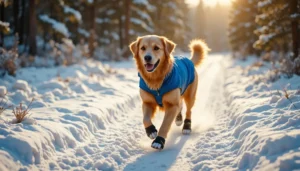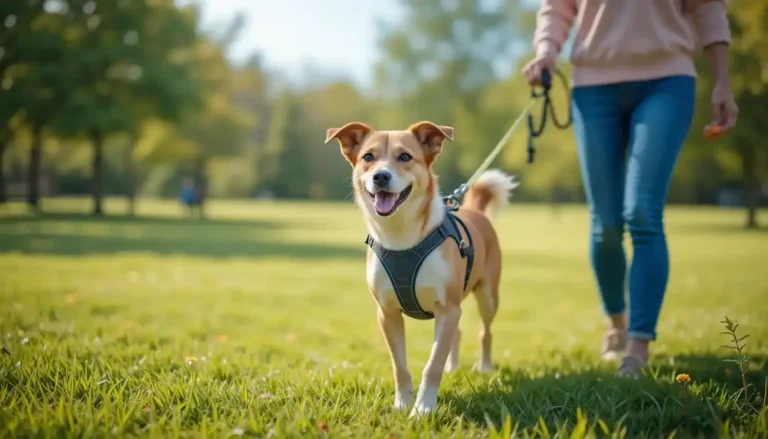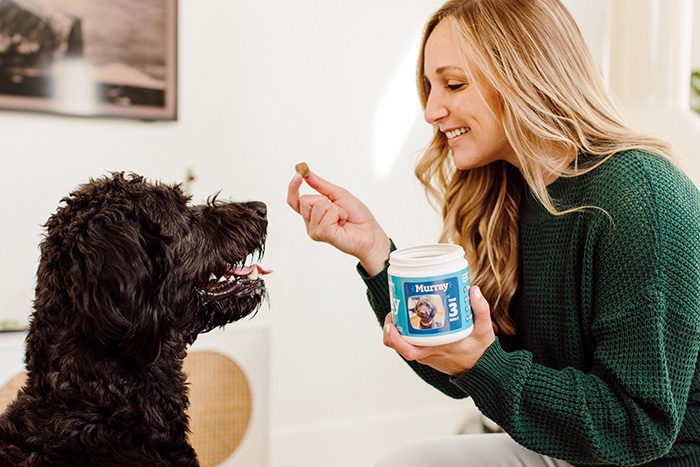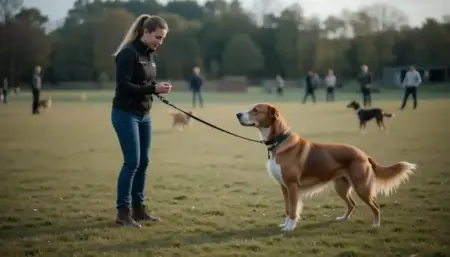Learning how to train a reactive dog on leash starts with recognizing that a dog’s outbursts are fear‑driven signals, not willful disobedience. By using low‑stress exposure, high‑value rewards, and consistent timing, you can rewire the dog’s emotional response and enjoy calm walks together.
In this guide, we explain the science behind leash reactivity, show you the tools you need, and walk you through proven training techniques—desensitization, counter‑conditioning, and positive reinforcement—so you can confidently answer the question “how to train a reactive dog on leash” in any setting.
What Is a Reactive Dog?
A reactive dog reacts excessively to everyday stimuli such as other dogs, strangers, or sudden noises. The behavior is a form of communication, not aggression.
- Barking, lunging, or growling usually means the dog feels threatened or overwhelmed.
- Body language, such as a stiff tail, pinned ears, or wide‑set eyes, signals rising stress.
- Reactiveness varies from mild (a brief bark) to severe (full‑blown lunges).
Understanding that reactivity is fear‑based helps you avoid punishment-based solutions that only increase anxiety. The goal is to replace the fear response with a calm, confident one.
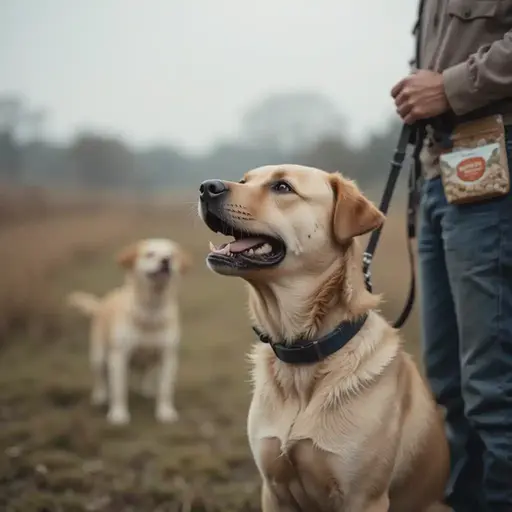
Why Dogs Become Reactive on Leash
Leash reactivity isn’t a personality flaw; it’s a response to a specific set of conditions.
- Restricted Escape Routes – A leash removes the dog’s ability to retreat, so the “flight” option disappears, leaving “fight” as the default response.
- Past Trauma – Dogs that have been forced into close contact with other dogs or people may anticipate danger when they see a trigger.
- Socialization Gaps – Puppies that miss the critical socialization window (roughly 8‑14 weeks) often lack confidence around new stimuli.
- Breed Tendencies – Herding and guarding breeds can be wired to focus intensely on perceived threats.
A combination of these factors creates a high‑stress feedback loop that intensifies reactivity each time the dog is walked.
How to Train a Reactive Dog on Leash: Understanding the Basics
Common Triggers for Leash Reactivity
| Trigger | Typical Reaction | Why It Stresses the Dog |
|---|---|---|
| Other dogs (especially unfamiliar) | Bark, lunge, growl | Perceived competition for space |
| Strangers or groups of people | Stiffening, barking | Fear of sudden movements |
| Fast‑moving objects (bicycles, skateboards) | Snap, jump | Unpredictable speed |
| Loud noises (construction, sirens) | Freeze or bark | Startle response |
Identifying the exact trigger is the first step in how to train a reactive dog on leash because it tells you where to start the desensitization ladder.
The Role of Fear and Frustration
- Fear arises when the dog feels trapped; the amygdala lights up, releasing adrenaline and cortisol.
- Frustration appears when the dog wants to investigate, but the leash blocks it, leading to redirected aggression.
Both emotions share the same physiological pathway, so a successful training plan must address both simultaneously.
How Leash Restriction Amplifies the Response
Research in Applied Animal Behaviour Science shows that restrained dogs have elevated cortisol—a stress hormone—compared with off‑leash dogs in neutral environments. The leash creates a “trapped” sensation that the dog interprets as a threat, prompting reactive outbursts.
Key Insight: When you know how to train a reactive dog on leash, the first rule is to manage the leash so the dog never feels forced into a corner.
Preparing for Training
Choosing the Right Equipment
| Equipment | Why It Helps | Tips for Use |
|---|---|---|
| Front‑clip harness (e.g., Freedom No‑Pull) | Redirects pulling forward, reducing pressure on the neck | Adjust snugly but not too tight; attach leash to front clip |
| Fixed‑length leash (6‑8 ft) | Provides consistent distance, making exposure easier to gauge | Avoid retractable leashes that can jerk suddenly |
| Treat pouch or pocket | Allows quick reward delivery, crucial for counter‑conditioning | Keep high‑value treats (cheese, chicken) ready at all times |
| Clicker (optional) | Marks the exact moment of calm, sharpening learning | Pair click with treat within 1‑2 seconds |
Avoid choke chains, prong collars, or anything that causes pain—these heighten fear and sabotage how to train a reactive dog on leash.
Setting Up a Structured Training Plan
- Assess the Threshold – Start at a distance where the dog notices the trigger but stays relaxed (usually 15‑20 ft).
- Create a Schedule – 5‑10 minute sessions, 1‑2 times daily, are more effective than occasional long walks.
- Track Progress – Use a simple log: date, location, trigger distance, dog’s reaction, and reward used.
A measurable plan keeps you honest and lets you see incremental gains, which is motivating for both you and the dog.
Creating a Low‑Stress Practice Zone
- Select a quiet area: Empty parking lots, backyards, or low‑traffic parks.
- Control the environment: Turn off phone notifications, avoid loud music, and limit the number of people present.
- Add Positive Associations: Before training, toss a few treats in the area to create a “happy zone.”
When the practice zone feels safe, the dog is more likely to stay calm during exposure exercises. Sure exercises.

Step‑by‑Step Training Techniques
Desensitization – Gentle Exposure
Desensitization is the backbone of how to train a reactive dog on leash. It works by lowering the dog’s emotional response to a trigger through repeated, low‑intensity exposure.
How to do it:
- Find the Trigger Distance – Use a friend or a second dog on a long leash. Stand where your dog notices the other dog but remains relaxed.
- Mark Calm – As soon as the dog glances at the trigger without tension, click (or say “yes”) and give a treat.
- Stay Within Threshold – If the dog shows signs of stress (tightened body, whining), step back a few feet.
- Gradually Close the Gap – Over days or weeks, shave off 1‑2 ft each session, always rewarding calm before anxiety builds.
Pro Tip: Keep sessions short. A 5‑minute “low‑intensity” exposure is more productive than a 30‑minute struggle.
Counter‑Conditioning – Pairing Triggers with Rewards
Counter‑conditioning rewires the emotional link between the trigger and a positive outcome.
Implementation Steps:
- Introduce the Trigger – As the trigger appears (e.g., a passing cyclist), immediately give a high‑value treat.
- Maintain Timing – The reward must arrive before the dog escalates. Ideally, within 1 second of the trigger’s appearance.
- Repeat Consistently – Do this every time the trigger shows up, even if the dog is slightly tense. Consistency overrides the old fear association.
- Phase Out Treats Slowly – Once the dog reliably anticipates a reward on sight of the trigger, begin rewarding every third or fifth occurrence, then replace treats with praise and a quick “good job.”
Counter‑conditioning is a core component of how to train a reactive dog on leash because it changes the dog’s expectation from “danger” to “treat.”
Positive Reinforcement – Rewarding Calm Behavior
Positive reinforcement is the most reliable way to shape new, lasting habits.
- Mark the Desired Behavior – Use a clicker, word (“yes”), or a gentle pat the moment the dog looks away from the trigger or stays still.
- Deliver a High‑Value Reward – Treats should be more enticing than anything the trigger could offer (e.g., a piece of hot dog).
- Vary the Rewards – Mix in verbal praise, a short play session, or a quick game of fetch to keep the dog engaged.
- Ignore Unwanted Reactivity – Do not shout or yank the leash; simply turn away or step back, then resume training at a lower intensity.
A study in Veterinary Medicine and Science found that dogs trained with pure positive reinforcement showed a 40% drop in cortisol after eight weeks compared with dogs subjected to correction‑based methods.
Advanced Tools – Clicker and Cue Training
Adding a clicker or a specific cue like “watch me” can accelerate learning.
- Clicker Conditioning – First, teach the dog that a click means “treat is coming.” Then use the click to mark calm moments during leash exposure.
- Cue “Look/Focus” – Train the dog to make eye contact on command. When a trigger appears, give the cue, and reward the dog for maintaining focus on you instead of the trigger.
These tools give you a precise way to communicate during high‑stakes moments, making how to train a reactive dog on leash smoother and more reliable.
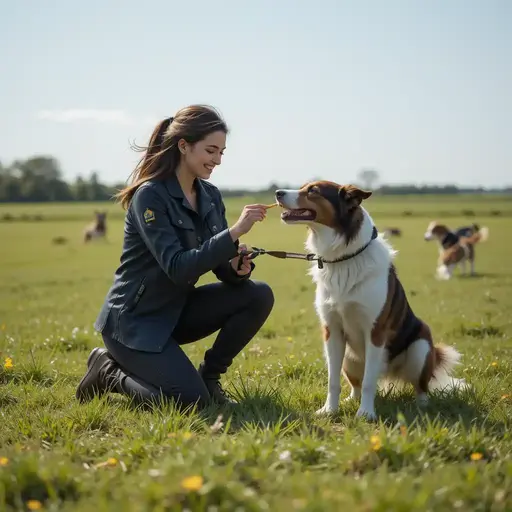
Managing Walks with a Reactive Dog
Choosing the Best Times and Places
- Walk Early or Late – Light traffic means fewer unpredictable triggers.
- Select Low‑Density Areas – Wide parks, quiet residential streets, or empty trails give you more control over distance.
- Stick to Predictable Routes – Dogs thrive on routine; a familiar path reduces surprise stimuli.
Handling Unexpected Triggers
- Create Immediate Distance – If a dog appears suddenly, calmly step to the side or cross the street.
- Use a “U‑Turn” – Pivot 180° while keeping a steady pace, then reward the dog for following.
- Maintain Forward Momentum – Avoid stopping; a continuous, relaxed walk signals safety.
Never yank the leash. A short, firm “no‑pull” tug can increase anxiety, reinforcing the very reactivity you’re trying to eliminate.
Distraction and Redirection Techniques
- Cue “Sit‑Stay” – Ask for a sit and stay a few feet away from the trigger; reward once the dog complies.
- Play “Find It” – Toss a treat a few steps ahead and encourage the dog to sniff it, shifting focus away from the trigger.
- Use a Scented Chew – A busy chewer (e.g., a Kong™ stuffed with peanut butter) occupies the mind and reduces hyper‑vigilance.
Consistent redirection trains the brain to expect a positive outcome when a trigger appears, reinforcing the lessons learned in your training sessions.
Common Mistakes and How to Avoid Them
Why Punishment Backfires
- Increases Fear – Yelling or leash corrections raise cortisol, heightening anxiety.
- Damages Trust – The dog learns to associate you with pain, not safety.
- Creates Aggression Loops – Punishment can turn fear into defensive aggression.
Research shows punishment‑based methods lead to a 50% higher recurrence of reactivity versus reward‑based approaches.
Solution: Stick to rewarding calm behavior and ignore unwanted outbursts.
The Dangers of Forcing Interactions
- Flooding the System – Exposing a dog to a trigger at full intensity overwhelms its coping mechanisms, causing shutdown or escalation.
- Solidifies Negative Associations – The dog links the trigger with unbearable stress.
Solution: Respect the threshold distance. Progress only when the dog shows at least a 70% calm rate at a given distance.
Consistency Is Crucial
- Skipping Sessions leads to confusion; the dog cannot link the cue and reward reliably.
- Mixed Signals (sometimes rewarding, correcting), slow learning, and increased anxiety.
Best Practice: Schedule daily micro‑sessions, track them, and keep rewards consistent. A steady routine accelerates neural rewiring. Ons, track them, and keep rewards consistent. A steady routine accelerates neural rewiring.

Advanced Tips & Expert Insights
When to Seek Professional Help
- Escalating Aggression – If the dog lunges, growls, or bites despite consistent training, a certified veterinary behaviorist should assess possible medical or neurological factors.
- Multiple Triggers – Dogs reacting to a wide array of stimuli (people, bikes, cars) often need a customized desensitization plan.
- Owner Stress – If you feel overwhelmed, professional guidance can prevent accidental reinforcement of fear.
Early expert involvement reduces the risk of chronic fear conditioning.
Incorporating Mental Stimulation & Exercise
- Puzzle Feeders – Kongs, snuffle mats, or treat‑dispensing toys tap into natural foraging instincts and lower baseline stress.
- Structured Obedience Drills – Short “stay,” “leave it,” or “heel” exercises improve impulse control, a skill that directly supports leash calmness.
- Controlled Social Play – Arrange meetings with calm, vaccinated dogs in a neutral, fenced area. Start at a distance and reward relaxed behavior.
Studies indicate that dogs with 30+ minutes of daily mental enrichment reduce reactive episodes by up to 25%.
Long‑Term Maintenance Strategies
- Weekly Refresher Sessions – Even after success, devote 5 minutes each week to redo the desensitization ladder.
- Monitor Environmental Changes – New construction, new neighbors, or a different route can re‑trigger anxiety; be ready to adjust distance.
- Never Stop Rewarding Calm – Randomly sprinkle high‑value treats on walks to keep the calm association strong.
Consistent reinforcement secures the neural pathways you built during training, ensuring the dog stays relaxed for life.
FAQs
Can a reactive dog ever be calm on leash?
Yes. Most reactive dogs improve dramatically with reward‑based training. Consistent desensitization, counter‑conditioning, and positive reinforcement can rewire fear responses, leading to calm walks in many cases.
How long does it take to see results?
Mild changes often appear within 2–4 weeks of daily practice, while solid, lasting improvement typically takes 2–6 months, depending on the dog’s age, severity of reactivity, and consistency of training.
What if my dog reacts to people more than other dogs?
Treat people the same way as other triggers: start at a safe distance, use high‑value treats the moment a stranger appears, and gradually close the gap while rewarding calm. Over time, the dog learns that people are also associated with positive outcomes.
Is it okay to use a choke chain or prong collar?
No. Punitive tools increase fear and cortisol, worsening reactivity. Opt for a front‑clip harness or a gentle leader that gives you control without causing pain.
When should I consider hiring a professional trainer?
If the dog’s lunges become hard to control, if there’s any biting, or if you’re unable to progress after several weeks of consistent training, a certified positive‑reinforcement trainer or veterinary behaviorist should be consulted.
Conclusion
Training a reactive dog on leash hinges on understanding fear, managing exposure, and rewarding calm.
Start by identifying triggers, selecting low‑stress equipment, and following a structured plan of desensitization, counter‑conditioning, and positive reinforcement.
Avoid punishment, stay consistent, and gradually increase difficulty while keeping rewards high.
With patience and the right tools, you’ll transform stressful walks into confident outings—so grab a treat pouch, pick a quiet route, and begin building a calmer partnership today.

